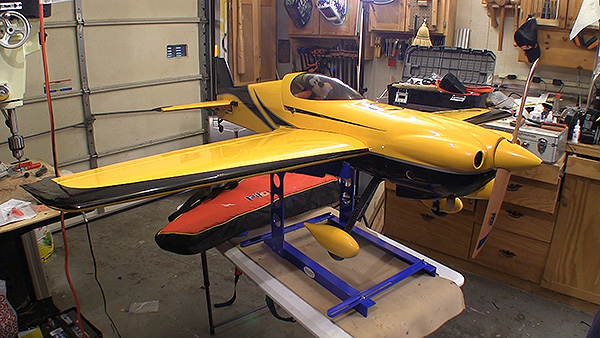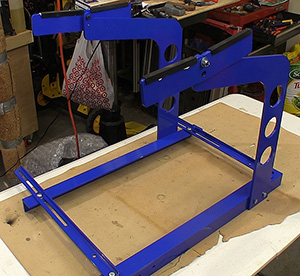



Along with ease of use, the dead-on accuracy of the EZ Balancer is worth the price.
Text, photos and video by Tom Hintz
Posted - 4-21-2015
One of the problems we run into with larger planes is how to balance them accurately. The days of simply balancing the model on our fingertips are gone. Unless you have arms long enough to be considered a deformity you can’t reach the CG location on most of the bigger planes and clear the prop and spinner at the same time. I have found myself in contorted positions on the floor of my shop trying to reach the CG marks on my bigger planes with frustration being the only consistent result.
After searching the Internet it was becoming obvious that the “home brew” balancers out there weren’t any better than the ideas I had. Then I came across the EZ Balancer II and balance in the giant scale world seemed possible at last. As I feared, accuracy and simplicity does not come cheap. The EZ Balancer II is selling for $229.95 (4-20-2015) per copy. Takes your breath away a little doesn’t it?
In defense of the EZ Balancer II it is very well built, (American made) is very accurate and is easy to use accurately. It is made from aircraft quality aluminum with the parts cut by a water jet. It has a nice looking blue powder coat finish and folds flat to make storing it as simple as it gets. Over all the EZ Balancer II is 18”-tall, 23”-long and 18”-wide at the cross pieces. You can set the cradles up to 18” apart to best fit the plane being worked with.
An important feature of the EZ Balancer II is that the cradles in which the plane sits are limited in movement so the plane can’t just tip over and fall off. The bolts/pivots on which the cradles ride are machined and do their job well. I put a light coat of oil on them during assembly to make sure that they rock freely. You also get rubber covers for the cradles that prevent damage to the plane and add another level of anti-slip to keep the plane stable during balancing.
The design allows balancing many
types and sizes of aircraft easily.
Part of the reason to make sure the plane does not slip is that the EZ Balancer II cradles have a notch at their center that functions as a sight. You make a pencil line at the CG point of the wing (I put a piece of masking tape on the wing and draw the line on that) and put that line directly over the notch. If you are accurate in drawing the line and then putting it directly over the notch, the plane has to be perfectly aligned on the EZ Balancer II. That makes the balance test super accurate and will probably let you get a better CG balance than ever before.
The only reason included the “In the Shop” section is that the EZ Balancer II is so remarkably easy to use and yet be accurate with a precision that would be difficult any other way. The toughest part of using the EZ Balancer II for me was putting my larger planes on it.
Because the EZ Balancer II is under the plane, working around it to reposition batteries or other components is easy even if your shop is not as big as you’d like. That can be a big help when you need to concentrate on one end of the other to get a plane perfectly balanced. Here again, it’s easy to be very accurate because of how the EZ Balancer II is designed and works.
I know the price tag of $229.95 will set some RC’rs on fire so just keep in mind that nobody is making anyone buy it. I also think the price is high but because I work alone and can’t afford to guess at CG locations the EZ Balancer II makes sense. It fits my needs, my shop and my planes. I had to make it fit my budget which was hard but easier than replacing a crashed out of balance plane kit.
Part of me knows that cheaper stuff is cheaper for a reason. I have always believed that paying for quality is going to be necessary most times. Could I make a version of the EZ Balancer II? Perhaps but that would mean a bunch of time and some material costs to make something that might not be so accurate, so stable, so easy to use and so easy to store. The quality of the materials and workmanship promise a long useful life for the EZ Balancer II and that makes it easier for me to live with the price.
Visit the EZ Balancer II web page – Click Here
Have a comment on this Review? –Email Me!